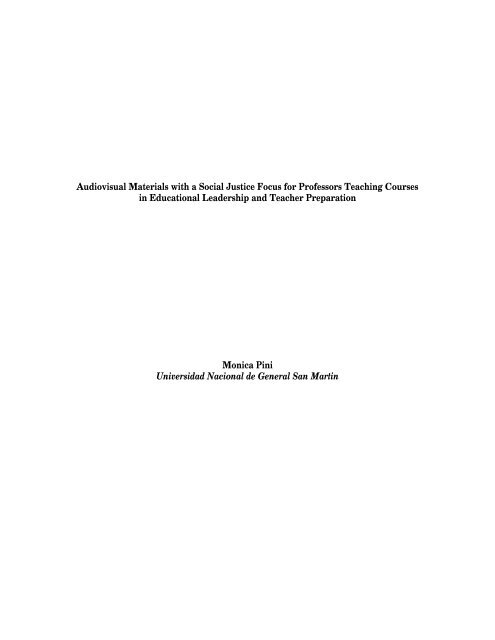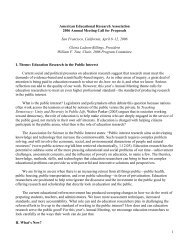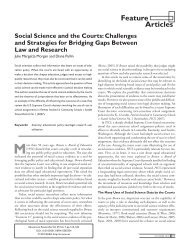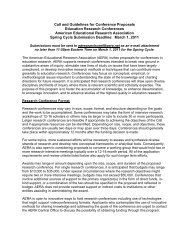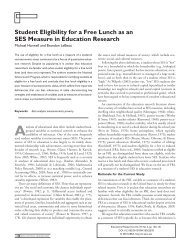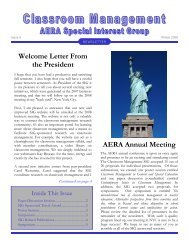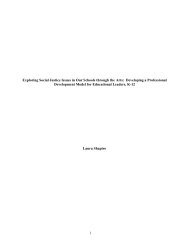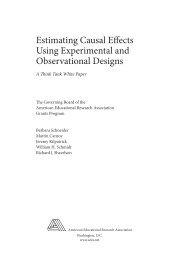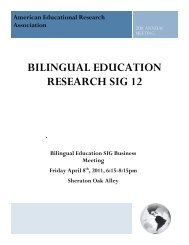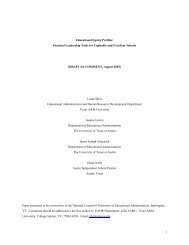Audiovisual Materials with a Social Justice Focus for Professors ...
Audiovisual Materials with a Social Justice Focus for Professors ...
Audiovisual Materials with a Social Justice Focus for Professors ...
You also want an ePaper? Increase the reach of your titles
YUMPU automatically turns print PDFs into web optimized ePapers that Google loves.
<strong>Audiovisual</strong> <strong>Materials</strong> <strong>with</strong> a <strong>Social</strong> <strong>Justice</strong> <strong>Focus</strong> <strong>for</strong> <strong>Professors</strong> Teaching Courses<br />
in Educational Leadership and Teacher Preparation<br />
Monica Pini<br />
Universidad Nacional de General San Martin
<strong>Audiovisual</strong> <strong>Materials</strong> <strong>with</strong> a <strong>Social</strong> <strong>Justice</strong> <strong>Focus</strong> <strong>for</strong> <strong>Professors</strong> Teaching Courses<br />
in Educational Leadership and Teacher Preparation<br />
Abstract:<br />
Monica Pini<br />
Universidad Nacional de General San Martin<br />
This project developed academic audiovisual materials using Power Point in order<br />
to increase the scarce availability of such resources to support arguments related to social<br />
justice in the preparation of leaders and teachers in education. The materials document<br />
social injustices in different aspects of social life that impact education and are available<br />
to programs <strong>for</strong> administrators and teachers.
<strong>Audiovisual</strong> <strong>Materials</strong> <strong>with</strong> a <strong>Social</strong> <strong>Justice</strong> <strong>Focus</strong> <strong>for</strong> <strong>Professors</strong> Teaching Courses<br />
in Educational Leadership and Teacher Preparation<br />
Introduction<br />
Monica Pini<br />
Universidad Nacional de General San Martin<br />
The purpose of this project was to develop academic audiovisual materials using<br />
Power Point in order to increase the scarce availability of such resources to support<br />
arguments and ideas related to social justice in courses in politics and administration of<br />
education. The materials document social injustices in different aspects of social life that<br />
impact education and are available to programs <strong>for</strong> administrators and teachers. One of<br />
the objectives of this project was to disseminate the materials to professors in different<br />
universities at no cost.<br />
Often professors need to present data in class that challenges prejudices that their<br />
students acquire through the mainstream media. In postmodern societies it is usual that<br />
people learn more from media than inside schools and colleges. Most students are seldom<br />
exposed to data that describes social inequalities and the impact of these inequalities on<br />
the welfare of children and families. The materials, besides trying to in<strong>for</strong>m about<br />
injustices, want to be an invitation to explore more these issues in class, to fill the<br />
in<strong>for</strong>mative gaps at universities, schools, and mass media, producing new material <strong>for</strong><br />
and <strong>with</strong> the students, and over all, to reflect together about the relationship between<br />
social practices and school practices.<br />
The visual materials, supported by “Power Point” software, cover the following<br />
topics:<br />
<strong>Social</strong> Inequalities and Children<br />
<strong>Social</strong> Inequalities in Schools<br />
<strong>Social</strong> Inequalities associated <strong>with</strong> Race and Ethnicity<br />
Privatization of American public schools (Part I and II)<br />
Corporatization of American Public Schools<br />
In what follows, I provide the background of the topics, the description of the<br />
materials, and some general suggestions to use them <strong>with</strong> students. According to a<br />
democratic pedagogy, my suggestions focus on active, reflective, critical, and cooperative<br />
learning activities, creating an environment that encourages and facilitates studentstudent<br />
and student-faculty interaction and showing respect <strong>for</strong> students’ differences. The<br />
idea is to use, modify, adapt and take these suggested activities as models to create more<br />
examples which can be shared <strong>with</strong> other colleagues.
Blaming Schools<br />
In most federal documents and official discourses we find that education is both<br />
the origin and the solution of most social problems. At the same time, numerous reports<br />
affirm that one of the reasons <strong>for</strong> public school failure is the poor quality of teachers and<br />
curricula (Apple, 2000). These assertions are part of a rhetoric that has served to diminish<br />
the role of teachers and public schools in order to mask real problems and to benefit the<br />
interests of a few. Public schools are immersed in the environment where they work and<br />
in the serious situations that the students they serve live in. Teachers and administrators<br />
know that, but they need to have more in<strong>for</strong>mation and more tools to analyze and reflect<br />
about it. Un<strong>for</strong>tunately, schools tend to reproduce unjust conditions unless critical<br />
analysis and collective initiatives <strong>for</strong> change are put in place.<br />
Thinking that improved education will aid in the solution of social problems is<br />
very common, and it is true that education could help a lot. But to lay the whole<br />
responsibility on education instead of on the whole society –beyond being a rhetoric<br />
resource—could be a dangerous challenge. The trap is that if the education goals<br />
pertaining to these problems are not achieved (which surely happen if no other consistent<br />
strategies are adopted) people can blame public schools <strong>for</strong> not “fixing” a myriad of<br />
social problems, in spite of the given support. According to Liston and Zeigner (1997)<br />
educational interventions cannot, by themselves, solve problems of inequity at schools.<br />
Are American public schools truly delivering substandard or inferior education?<br />
There is no one answer. With few exceptions, it is better to be a student in a suburban<br />
school. If one looks at the situation of schools in urban and poor neighborhoods, drop out<br />
rates and the gap between White middle-class and minority students’ achievement is<br />
substantial. According to Berliner and Biddle (1996), the “manufactured crisis” in<br />
education is masking the root problem: inequality. Furthermore, this inequality is in part<br />
accepted “collateral damage” that results from the market economy, a dynamic in which<br />
poor children are not deemed worthy of a superior education (Saltman, 2000). However,<br />
the academic achievement gap between White and Black students is also evident in<br />
suburban schools, reflecting the historical and chronic discrimination against minorities<br />
(Spring, 2001; Tyack & Cuban, 1995).<br />
Jonathan Kozol’s (1991) well-known book, Savage Inequalities, is a heartbreaking<br />
chronicle of poor, mostly Black and Hispanic children schooled in inner or<br />
isolated cities. In spite of the book’s popularity, it became an icon—respected but<br />
neglected—rather than a resource <strong>for</strong> parents and educators to reflect on and to change<br />
the devastating conditions Kozol chronicles. He shows that behind “pedagogic” solutions<br />
offered by local districts <strong>for</strong> urban schools there is often a reluctance to avoid recognizing<br />
injustice, inequality or segregation as sources of educational problems (p. 51). According<br />
to Giroux (2000), these inequalities particularly affect minority youth: “Latino and Black<br />
youth bear the burden of an adult society that either views them as disposable and as a<br />
threat to middle-class life, or reifies them through a commercial logic in search of a new<br />
market niche” (p. 14).
On the other hand and in spite of enormous class, gender, race, and sexual<br />
orientation disparities in schools, the struggles of the Civil Rights movement have<br />
generated a gradual increase of educational opportunities <strong>for</strong> minority children in<br />
comparison to earlier decades (Tyack, 1974; Spring, 2001). The growth in school<br />
enrollment along <strong>with</strong> increasing economic polarization between rich and poor makes<br />
one wonder if the ultimate political goal of the privatizing movement is to stop the slow<br />
but constant trend to democratize the American public school system. For many<br />
conservative Americans there are too many Hispanic, Black, Asian, and lower-class<br />
people being educated at public expense. The world-class society they envision will not<br />
need so many well-educated people who have raised expectations and are able and<br />
willing to exercise their civil rights.<br />
There are more common issues at school related to social justice which we need<br />
to think about. Believing that education results could be represented by standards that can<br />
be measured by tests, <strong>for</strong> example, constitutes, from this perspective, a reductionist view,<br />
coming in part from a culture of efficiency and competitiveness. This view does not take<br />
into account that neither exact measurement nor quantification can reflect complex social<br />
or individual processes such as learning, including social conditions of learners. The<br />
results of such tests reflect a limited scope of learned knowledge, including the skills<br />
needed to respond to that particular <strong>for</strong>m of testing. These limitations make measuring<br />
results just in relation to standards a discriminating practice.<br />
The issue of school choice has become one of the hottest controversies in<br />
American education, because it calls into question some of the central premises of the<br />
educational system. These questions include: who should have access to education; what<br />
are the goals of education; what is the role of the state; and what is the validity of<br />
democratic values such as freedom and equality, the separation of state and church,<br />
democratic participation, and how an intangible good like education is best distributed.<br />
If one’s ideals and hopes <strong>for</strong> education are closer to John Dewey’s and Paulo Freire’s<br />
than to Milton Friedman’s or E. D. Hirsh’s, then one would agree that improving schools<br />
means creating classrooms <strong>for</strong> equity and social justice through educational practices that<br />
are grounded in students’ lives. One would hope <strong>for</strong> practices that are anti-racist,<br />
participatory, activist, hopeful, joyful, kind, and visionary (Engel, 2000). This notion of<br />
education is strongly linked to public education’s role in teaching civic values.<br />
Political Background<br />
Even though poverty and injustice were not new, the neoconservative era<br />
contributed to increase them. The Reagan presidency meant “a significant shift in the<br />
discourse on social engineering, as state remedy <strong>for</strong> social problems lost ground to<br />
market-based remedies” (Labaree, 1997, p. 137). The Reagan administration’s ideology<br />
claimed that government bureaucracy was ineffective, inefficient in managing social<br />
services, and that the private sector was better able to play that role. In 1983, the<br />
publishing of Nation at Risk signaled the beginning of a powerful attack against public
schools and started the campaign in favor of a market-model, in which free choice and<br />
competition appear as the primary values in education.<br />
Apple (1996) asserts that, even though neoconservatives 1 emphasize traditional<br />
values, and neoliberals market ones, both of them have joined together to make schools<br />
responsible <strong>for</strong> the majority of social problems. According to this author, “powerful<br />
groups <strong>with</strong>in government and the economy, and <strong>with</strong>in ‘authoritarian populist’ social<br />
movements, have been able to redefine –often in very retrogressive ways—the terms of<br />
the debate in education, social welfare, and other areas of the common good”. This<br />
alliance “combines business <strong>with</strong> the new right and <strong>with</strong> neoconservative intellectuals”<br />
(p. 27-28). The main proposals of this “power bloc” include the implementation of school<br />
choice programs such as vouchers or tax credits, the movement to raise standards, the<br />
attack on public schools <strong>for</strong> not promoting traditional Western values, and the inclusion<br />
of business needs into the goals of education.<br />
It seems evident that education is a nationally sensitive topic, or perhaps it is the<br />
topic selected by the two main political parties in order to generate unity be<strong>for</strong>e a<br />
perceived “serious” situation. The “crisis of American education,” or, better, the crisis of<br />
the American public school system, that is being agitated by alarmist discourses<br />
(especially since the publication of Nation at Risk in 1983), is a common place, as is the<br />
seeking of solutions that are expressed in diverse re<strong>for</strong>m proposals and tense<br />
controversies. Popkewitz (1997) expressed the catastrophic-patriotic tone of this and<br />
similar documents directed primarily to the “common citizen” eloquently: “Instead of<br />
analysis, these reports offer exhortations and prophecies. Their language protests <strong>for</strong> the<br />
loss of grace of the nation and promotes the rectitude of action as means through which<br />
redemption becomes possible” (p. 166). It is not necessary to clarify that the tool <strong>for</strong> this<br />
redemption is the school. That is why schools are in the center of such intense struggles.<br />
Other scholars, as Berliner and Biddle (1995), affirm that the “manufactured<br />
crisis” is not an accidental event, but rather “it appeared <strong>with</strong>in a specific historical<br />
context and was led by identifiable critics whose political goals could be furthered by<br />
scapegoating educators” (p. 4). For his part, Lind (quoted by Spring, 1997), wondered<br />
whether this “war” against public schools is not a smoke screen from the Republican<br />
Right to hide the economic crisis and the growing economic inequalities. From a similar<br />
position, Liston and Zeigner (1997) argue that "the so agitated American schools’ crisis<br />
is, actually, the reflect of the whole society general crisis” (p. 21).<br />
At the same time, we find the moralizing push of the religious right, who claim<br />
that “the solution to public problems was teaching of morality and Western cultural<br />
values” (Spring, 1997, p. 5). From their perspective, the liberal (political and cultural)<br />
elite and federal bureaucracy are the main dissolvent factors that promote national secular<br />
and desegregationist policies that do not promote community initiatives. Within this<br />
view, pornography and drug abuse go together <strong>with</strong> sex education and secular humanism.<br />
The proposal to include prayer in public schools, <strong>for</strong> example, is one of the ways the<br />
1 Neoconservatism refers to the connection between neoliberalism and the religious right.
eligious right seeks to resist this decadence. These ideas also have strong economic<br />
support from corporations and foundations which promote certain political candidates.
Description of the <strong>Materials</strong> and Suggestions <strong>for</strong> their Use in Class<br />
<strong>Social</strong> Inequalities and Children<br />
This visual material is about children in poverty reporting some data about the<br />
state of America’s children in 2000. The data is related to average family income and to<br />
the lack of child safety net policies in the United States.<br />
Suggested Exercises<br />
Have the students:<br />
1. Search in Internet different or missing data about the topic and analyze them in groups.<br />
2. Search and compare the same kind of data among states and school districts.<br />
3. Look <strong>for</strong> related news, make a portfolio, and analyze if and how frequently the texts<br />
relation child’s poverty <strong>with</strong> family income or social policies.<br />
4. Find groups and associations at state or community level that fight against child<br />
poverty and summarize their principles and activities.
<strong>Social</strong> Inequalities in Schools<br />
This material includes the characterization of most schools <strong>for</strong> minority students.<br />
Accepted discrimination in different <strong>for</strong>ms, especially the poor quality of schools <strong>for</strong><br />
poor and minority children, and inadequate school funding. The use of their influences by<br />
upper-class parents and ignoring research about classroom size are factors that contribute<br />
to consolidate inequalities.<br />
Suggested Exercises<br />
1. Ask the students to explain the relationship between school finance and the equal<br />
protection clause of the Fourteenth Amendment.<br />
2. Have students work together in small groups to analyze the following assertion and<br />
think how it is related to discrimination in school: "Educators have learned a lesson from<br />
business and industry: a key to success is defining clear, high standards of per<strong>for</strong>mance<br />
and a system that measures results in relation to those standards" (U. S. Department of<br />
Education, 1996, p. 8).<br />
3. From their experience as students, have them discuss the gender, racial and ethnic<br />
composition of their elementary and secondary school faculty and administrators. Has the<br />
pattern that emerges from their experience changed compared to the current school<br />
pattern?
<strong>Social</strong> Inequalities Associated <strong>with</strong> Race and Ethnicity<br />
Most of the in<strong>for</strong>mation in this material shows how these social inequalities are<br />
present at school. Since the comparison between educational attainment of White, Black,<br />
and Hispanic Kindergartners, the in<strong>for</strong>mation shows key facts about American children<br />
and schooling, such as the resegregation of school districts related to the expenses per<br />
student comparing different American cities. A graphic of bars comparing the median<br />
income by sex and race complete the material.<br />
Suggested Exercises<br />
Have the students:<br />
1. Look <strong>for</strong> demographic and financial data of schooling by race and ethnicity in selected<br />
states.<br />
2. Contact a particular academic department on campus and inquiry into the number of<br />
women and minorities who hold faculty positions in that department. The students may<br />
also consider inquiring into the gender and race of the head of the department, the top<br />
administrators in the college to which the department belongs, at the university or<br />
college, the department staff, and graduate and undergraduate registered students.<br />
3. Ask students from other classes <strong>for</strong> their own experience about institutional racism and<br />
sexism and discuss their stories in class.
Privatization of American Public Schools<br />
The material starts characterizing the education industry. Asking <strong>for</strong> the validity<br />
of values of public education is a way of contrasting to the positions that support school<br />
choice. I give different school choice positions, pros and cons, proposals, and place them<br />
in the context of the privatizing trend, showing market <strong>for</strong>ces and opponents’ arguments.<br />
In the second part I characterize two competing conceptions of education and society at<br />
the root of the struggle <strong>for</strong> public schools and explore the background and current<br />
expansion of the privatizing trend, describing its consequences <strong>for</strong> democracy.<br />
Suggested Exercises<br />
An important part of the work of presenting this material is the development of<br />
the American historic-political context <strong>with</strong>in which these strategies and policies have<br />
their origins and, fundamentally, an examination of the <strong>for</strong>ces that intervene in the<br />
struggle <strong>for</strong> the control of public schools by attempting to control public opinion. Within<br />
this framework, it is important to reflect on the logic of these policies and the connections<br />
that might be made <strong>with</strong> some other school “re<strong>for</strong>ms” that have been proposed and/or<br />
implemented.<br />
In its fourth annual report on trends in schoolhouse commercialism, the<br />
Commercialism in Education Research Unit (CERU) at Arizona State University<br />
determined that commercializing activity in and around schools has grown nearly 500<br />
percent since 1990. CERU studied media coverage of eight categories of<br />
commercializing activities in the popular press, advertising and marketing press, the<br />
business press and education press.<br />
Have the students:<br />
1. Synthesize, present and discuss in class the last studies made by the CERU.<br />
2. Look <strong>for</strong> cartoons about school re<strong>for</strong>m and privatization and analyze them to<br />
understand what position they support related to public schools.<br />
3. Look <strong>for</strong> parental school choice, vouchers and charter schools news. Classify the<br />
in<strong>for</strong>mation according to the arguments expressed related to public schools and discuss<br />
them in class.<br />
4. Summarize and discuss the arguments of the main unions about school choice and<br />
privatization.
Corporatization of American Public Schools<br />
The material shows how some private <strong>for</strong>-profit companies manage public schools,<br />
particularly charter schools. I analyze text excerpts from the web pages of some of the<br />
leading corporations, federal reports and statistics, state laws and reports, and academic<br />
research on charter schools. Conditions that favor Education Management Organizations<br />
(EMO) in some states are enumerated and connected to the effects on democratic values.<br />
Suggested Exercises<br />
Have the students:<br />
1. Make an overview of the “education industry” from the perspective of the industry<br />
(Business Week, Forbes, Newsweek, The Education Industry Report, etc.) and compare<br />
to an educational perspective.<br />
2. Place in a map the distribution of schools managed by Education management<br />
organizations (EMOs) and their head offices throughout the states.<br />
3. Analyze the charter school law in their state and explore the factors that could difficult<br />
or facilitate EMO’s operations in public schools.
Selected Resources<br />
A better balance: Standards, tests, and the tools to succeed. (2001, January)<br />
Special edition of Education Week.<br />
Anderson, S. and Cavanagh, J. (2000). Field guide to the global economy. New<br />
York; Institute <strong>for</strong> Policy Studies.<br />
Annie E. Casey Foundation (2001). Kids count data book: State Profiles of child<br />
well-being. Baltimore: Annie E. Casey Foundation.<br />
Children’s Defense Fund (2000). The state of America’s children: Yearbook<br />
2000. Boston: Beacon Press.<br />
Derber, C. (1998). Corporation Nation. New York; St. Martins Griffen.<br />
Frey, W.H., Abresch, B. and Yeasting, J. (2001). America by the numbers: A<br />
field guide to the U.S. population. New York: The New Press.<br />
Hajime Shinagawa, L. and Jang, M. (1998). Atlas of American diversity. Walnut<br />
Creek, CA: Altamira Press.<br />
Press.<br />
Rose, S. (2000). <strong>Social</strong> Stratification in the United States. New York: The New<br />
Tokman, V. and O’Donnell, G. (2001). Poverty and inequality in Latin America:<br />
Issues and new challenges. South Bend, IN: University of Notre Dame Press.<br />
United <strong>for</strong> a Fair Economy (1997). Born on third base: The sources of wealth of<br />
the Forbes 400.
Press.<br />
References<br />
Apple, Michael (1996). Cultural politics and education. NY: Teachers College<br />
Berliner, D. & Biddle, B. (1995). The manufactured crisis: Miths, fraud, and the<br />
attack on America’s public schools. NY: Longman.<br />
Engel, M. (2000). The struggle <strong>for</strong> control of public education. Market ideology<br />
vs. democratic values. Philadelphia: Temple University.<br />
Giroux, H. A. (2000). Stealing innocence. NY: Palgrave.<br />
Kozol, J. (1991). Savage inequalities. Children in America's schools. NY: Harper<br />
Perennial.<br />
Labaree, D. (1997). How to succeed in school <strong>with</strong>out really learning: The<br />
credentials race in American education. London & New Haven: Yale University Press.<br />
Liston, D. y Zeichner, K. (1997). Formación del profesorado y condiciones<br />
sociales de la escolarización (segunda edición). Madrid: Ediciones Morata, Paideia.<br />
Popkewitz, T. (1997). Sociología política de las re<strong>for</strong>mas educativas (segunda<br />
edición). Madrid: Ediciones Morata, Paideia.<br />
Saltman, K. J. (2000). Collateral damage.Corporatizing public schools--A threat<br />
to democracy. Lanham, Boulder, New York, Ox<strong>for</strong>d: Rowman & Littlefield Publishers,<br />
Inc.<br />
Spring, J. (2001). The American School: 1642-2000 (5 th ed.). New York, NY: Mc<br />
Graw Hill.<br />
Tyack, D. B. (1974). The one best system: A history of American Urban<br />
Education. Cambridge, Massachusetts, and London, England: Harvard University Press.<br />
Tyack, D. & Cuban, L. (1995). Tinkering toward utopia. A century of public<br />
school re<strong>for</strong>m. Cambridge, Massachusetts, and London, England: Harvard University<br />
Press.<br />
U.S. Department of Education (1996, April 30). Goals 2000: Increasing student<br />
achievement through state and local initiatives. Office of Educational research and<br />
Improvement. Educational Resources In<strong>for</strong>mation Center (ERIC)


